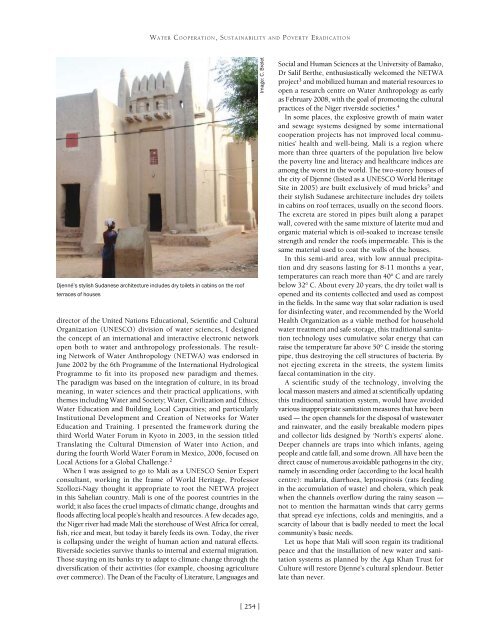222893e
222893e
222893e
You also want an ePaper? Increase the reach of your titles
YUMPU automatically turns print PDFs into web optimized ePapers that Google loves.
WATER COOPERATION, SUSTAINABILITY AND POVERTY ERADICATIONDjenné’s stylish Sudanese architecture includes dry toilets in cabins on the roofterraces of housesdirector of the United Nations Educational, Scientific and CulturalOrganization (UNESCO) division of water sciences, I designedthe concept of an international and interactive electronic networkopen both to water and anthropology professionals. The resultingNetwork of Water Anthropology (NETWA) was endorsed inJune 2002 by the 6th Programme of the International HydrologicalProgramme to fit into its proposed new paradigm and themes.The paradigm was based on the integration of culture, in its broadmeaning, in water sciences and their practical applications, withthemes including Water and Society; Water, Civilization and Ethics;Water Education and Building Local Capacities; and particularlyInstitutional Development and Creation of Networks for WaterEducation and Training. I presented the framework during thethird World Water Forum in Kyoto in 2003, in the session titledTranslating the Cultural Dimension of Water into Action, andduring the fourth World Water Forum in Mexico, 2006, focused onLocal Actions for a Global Challenge. 2When I was assigned to go to Mali as a UNESCO Senior Expertconsultant, working in the frame of World Heritage, ProfessorSzollozi-Nagy thought it appropriate to root the NETWA projectin this Sahelian country. Mali is one of the poorest countries in theworld; it also faces the cruel impacts of climatic change, droughts andfloods affecting local people’s health and resources. A few decades ago,the Niger river had made Mali the storehouse of West Africa for cereal,fish, rice and meat, but today it barely feeds its own. Today, the riveris collapsing under the weight of human action and natural effects.Riverside societies survive thanks to internal and external migration.Those staying on its banks try to adapt to climate change through thediversification of their activities (for example, choosing agricultureover commerce). The Dean of the Faculty of Literature, Languages andImage: C. BreletSocial and Human Sciences at the University of Bamako,Dr Salif Berthe, enthusiastically welcomed the NETWAproject 3 and mobilized human and material resources toopen a research centre on Water Anthropology as earlyas February 2008, with the goal of promoting the culturalpractices of the Niger riverside societies. 4In some places, the explosive growth of main waterand sewage systems designed by some internationalcooperation projects has not improved local communities’health and well-being. Mali is a region wheremore than three quarters of the population live belowthe poverty line and literacy and healthcare indices areamong the worst in the world. The two-storey houses ofthe city of Djenné (listed as a UNESCO World HeritageSite in 2005) are built exclusively of mud bricks 5 andtheir stylish Sudanese architecture includes dry toiletsin cabins on roof terraces, usually on the second floors.The excreta are stored in pipes built along a parapetwall, covered with the same mixture of laterite mud andorganic material which is oil-soaked to increase tensilestrength and render the roofs impermeable. This is thesame material used to coat the walls of the houses.In this semi-arid area, with low annual precipitationand dry seasons lasting for 8-11 months a year,temperatures can reach more than 40° C and are rarelybelow 32° C. About every 20 years, the dry toilet wall isopened and its contents collected and used as compostin the fields. In the same way that solar radiation is usedfor disinfecting water, and recommended by the WorldHealth Organization as a viable method for householdwater treatment and safe storage, this traditional sanitationtechnology uses cumulative solar energy that canraise the temperature far above 50° C inside the storingpipe, thus destroying the cell structures of bacteria. Bynot ejecting excreta in the streets, the system limitsfaecal contamination in the city.A scientific study of the technology, involving thelocal masson masters and aimed at scientifically updatingthis traditional sanitation system, would have avoidedvarious inappropriate sanitation measures that have beenused – the open channels for the disposal of wastewaterand rainwater, and the easily breakable modern pipesand collector lids designed by ‘North’s experts’ alone.Deeper channels are traps into which infants, ageingpeople and cattle fall, and some drown. All have been thedirect cause of numerous avoidable pathogens in the city,namely in ascending order (according to the local healthcentre): malaria, diarrhoea, leptospirosis (rats feedingin the accumulation of waste) and cholera, which peakwhen the channels overflow during the rainy season –not to mention the harmattan winds that carry germsthat spread eye infections, colds and meningitis, and ascarcity of labour that is badly needed to meet the localcommunity’s basic needs.Let us hope that Mali will soon regain its traditionalpeace and that the installation of new water and sanitationsystems as planned by the Aga Khan Trust forCulture will restore Djenné’s cultural splendour. Betterlate than never.[ 254 ]


